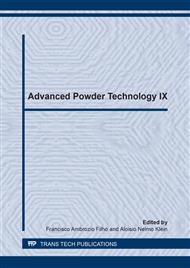[1]
Zhanheng Chen: Journal of Rare Earths Vol. 29 (2011), p.1.
Google Scholar
[2]
S. Moutinho: Ciência Hoje Vol. 52 (2013), pp.22-17. http: /cienciahoje. uol. com. br/revista-ch/2013/310/pdf_aberto/terrasraras. pdf.
Google Scholar
[3]
O.A. Serra: J. Braz. Chem. Soc. Vol. 22 (2011), p.811.
Google Scholar
[4]
M.Z. Jacobson and M.A. Delucchi: Energy Policy Vol. 39 (2011) p.1154.
Google Scholar
[5]
M. Simas, S. Pacca: Renewable and Sustainable Energy Reviews Vol. 31 (2014), p.83.
Google Scholar
[6]
A. Jordens, Ying Ping Cheng, K.E. Waters: Minerals Engineering Vol. 41(2013), p.97.
Google Scholar
[7]
Yan Chunhu, Jia Jiangtao , Liao Chunsheng, Wu Sheng, Xu Guangxian: Tsinghua Science And Technology. Vol. 11 (2006), p.241. http: /qhxb. lib. tsinghua. edu. cn/myweb/english/2006/2006e2/241-247. pdf.
DOI: 10.1016/s1007-0214(06)70183-3
Google Scholar
[8]
D. Kennedy. In: StrategischeRohstoffe — Risikovorsorge. Springer Spektrum, Berlin (2014), p.201.
Google Scholar
[9]
A.R. Johnson: JOM Vol. 40 (10) (1988), p.11.
Google Scholar
[10]
Geoff Bearne, Marc Dupuis and Gary Tarcy: Essential Readings in Light Metals Aluminum Reduction Technology (Wiley-TMS; New Jersey USA, Vol. 2 2013).
DOI: 10.1002/9781118647851
Google Scholar
[11]
H. Zhang, C.Q. Zhou, B. Wu and Jie Li: JOM Vol. 65 (2013), p.1452.
Google Scholar
[12]
H. Zhang, Jie Li, Zhigang Wang, Yujie Xu, and Yanqing Lai: JOM Vol. 62 (2010), p.26.
Google Scholar
[13]
J.F. Gerbeau, C. Le Bris and T. Lelièvre: Mathematical Methods for the Magnetohydrodynamics (Oxford Science Publications, 2006).
Google Scholar
[14]
E. Morrice, T.A. Henrie: Electrowinning high-purity neodymium, praseodymium, and didymium metals from their oxides [Washington, D.C. ] U.S. Dept. of the Interior, Bureau of Mines, (1967).
Google Scholar
[15]
E. Morrice, E.S. Shedd, and T.A. Henrie: Direct electrolysis of rare-earth oxides to metals and alloys in fluoride melts [Washington, D.C. ] U.S. Dept. of the Interior, Bureau of Mines, (1968).
Google Scholar
[16]
N. Krishnamurthy, C.K. Gupta: Extractive Metallurgy of Rare Earths. (CRC Press Boca 1st edition Raton Florida, 2004).
Google Scholar
[17]
S. Singh, J. M. Juneja, D.K. Bose: Journal of Applied Electrochemistry Vol. 25 (1995), p.1139.
Google Scholar
[18]
M. Earlam: Metallurgical Transactions B Vol. 21 (1990), p.599.
Google Scholar
[19]
R. Keller and K.T. Larimer: US department of Energy, Internal Report (1997), pp.1-62.
Google Scholar
[20]
J. Zoric, I. Rousiar, J. Thonstad and T. Haarberg: Journal of applied Electrochemistry Vol. 27 (1997), p.928.
DOI: 10.1023/a:1018401602274
Google Scholar
[21]
R.A. Sharma: JOM Journal of Metals Vol. 39 (2) (1987), p.33.
Google Scholar
[22]
M.C. Melaaen: Numerical Heat Transfer Vol 21 part B (1992), p.1.
Google Scholar
[23]
K.C. Karki, S.V. Patankar: Numerical Heat Transfer Vol. 14 (1988), p.295.
Google Scholar


